二十二届韩素音翻译大赛汉译英优秀译文
韩素音青翻译奖赛中文原文及参考译文和解析
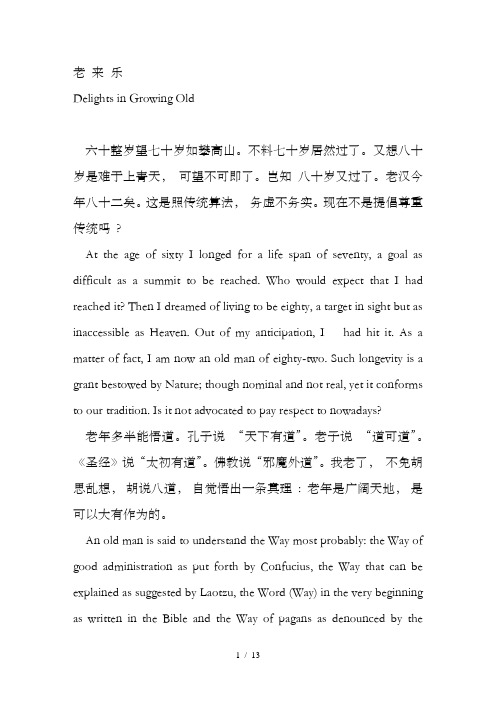
老来乐Delights in Growing Old六十整岁望七十岁如攀高山。
不料七十岁居然过了。
又想八十岁是难于上青天,可望不可即了。
岂知八十岁又过了。
老汉今年八十二矣。
这是照传统算法,务虚不务实。
现在不是提倡尊重传统吗?At the age of sixty I longed for a life span of seventy, a goal as difficult as a summit to be reached. Who would expect that I had reached it? Then I dreamed of living to be eighty, a target in sight but as inaccessible as Heaven. Out of my anticipation, I had hit it. As a matter of fact, I am now an old man of eighty-two. Such longevity is a grant bestowed by Nature; though nominal and not real, yet it conforms to our tradition. Is it not advocated to pay respect to nowadays?老年多半能悟道。
孔子说“天下有道”。
老子说“道可道”。
《圣经》说“太初有道”。
佛教说“邪魔外道”。
我老了,不免胡思乱想,胡说八道,自觉悟出一条真理: 老年是广阔天地,是可以大有作为的。
An old man is said to understand the Way most probably: the Way of good administration as put forth by Confucius, the Way that can be explained as suggested by Laotzu, the Word (Way) in the very beginning as written in the Bible and the Way of pagans as denounced by theBuddhists. As I am growing old, I can't help being given to flights of fancy and having my own Way of creating stories. However I have come to realize the truth: my old age serves as a vast world in which I can still have my talents employed fully and developed completely.七十岁开始可以诸事不做而拿退休金,不愁没有一碗饭吃,自由自在,自得其乐。
23届韩素音翻译竞赛英译汉原文
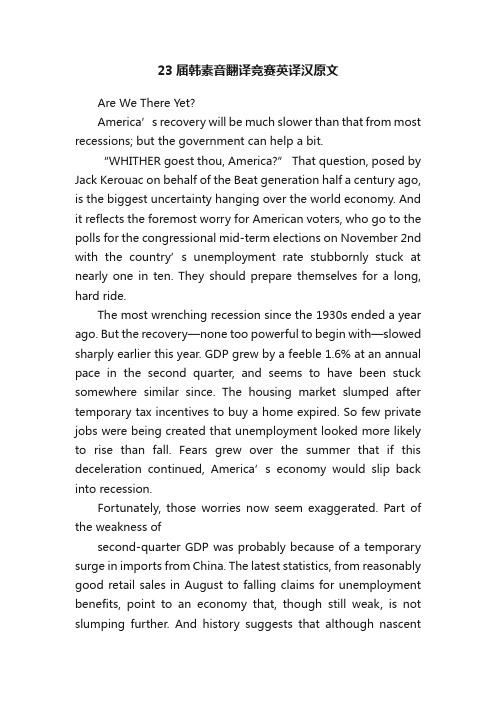
23届韩素音翻译竞赛英译汉原文Are We There Yet?America’s recovery will be much slower than that from most recessions; but the government can help a bit.“WHITHER goest thou, America?” That question, posed by Jack Kerouac on behalf of the Beat generation half a century ago, is the biggest uncertainty hanging over the world economy. And it reflects the foremost worry for American voters, who go to the polls for the congressional mid-term elections on November 2nd with the country’s unemployment rate stubbornly stuck at nearly one in ten. They should prepare themselves for a long, hard ride.The most wrenching recession since the 1930s ended a year ago. But the recovery—none too powerful to begin with—slowed sharply earlier this year. GDP grew by a feeble 1.6% at an annual pace in the second quarter, and seems to have been stuck somewhere similar since. The housing market slumped after temporary tax incentives to buy a home expired. So few private jobs were being created that unemployment looked more likely to rise than fall. Fears grew over the summer that if this deceleration continued, America’s economy would slip back into recession.Fortunately, those worries now seem exaggerated. Part of the weakness ofsecond-quarter GDP was probably because of a temporary surge in imports from China. The latest statistics, from reasonably good retail sales in August to falling claims for unemployment benefits, point to an economy that, though still weak, is not slumping further. And history suggests that although nascentrecoveries often wobble for a quarter or two, they rarely relapse into recession. For now, it is most likely that America’s economy will crawl along with growth at perhaps 2.5%: above stall speed, but far too slow to make much difference to the jobless rate.Why, given that America usually rebounds from recession, are the prospects so bleak? That’s because most past recessions have been caused by tight monetary policy. When policy is loosened, demand rebounds. This recession was the result of a financial crisis. Recoveries after financial crises are normally weak and slow as banking systems are repaired and balance-sheets rebuilt. Typically, this period of debt reduction lasts around seven years, which means America would emerge from it in 2014. By some measures, households are reducing their debt burdens unusually fast, but even optimistic seers do not think the process is much more than half over.Battling on the busAmerica’s biggest problem is that its politicians have yet to acknowledge that the economy is in for such a long, slow haul, let alone prepare for the consequences. A few brave officials are beginning to sound warnings that the jobless rate is likely to “stay high”. But the political debate is more about assigning blame for the recession than about suggesting imaginative ways to give more oomph to the recovery.Republicans argue that Barack Obama’s shift towards “big government” explains the economy’s weakness, and that high unemployment is proof that fiscal stimulus was a bad idea. In fact, most of the growth in government to date has been temporary and unavoidable; the longer-run growth in government is more modest, and reflects the policies of both Mr Obama and his predecessor. And the notion that high joblessness “proves”that stimulus failed is simply wrong. The mechan ics of a financial bust suggest that without a fiscal boost the recession would have been much worse.Democrats have their own class-warfare version of the blame game, in which Wall Street’s excesses caused the problem and higher taxes on high-earners are part of the solution. That is why Mr. Obama’s legislative priority before the mid-terms is to ensure that the Bush tax cuts expire at the end of this year for households earning more than $250,000 but are extended for everyone else.This takes an unnecessary risk with the short-term recovery. America’s experience in 1937 and Japan’s in 1997 are powerful evidence that ill-timed tax rises can tip weak economies back into recession. Higher taxes at the top, along with the waning of fiscal stimulus and belt-tightening by the states, will make a weak growth rate weaker still. Less noticed is that Mr. Obama’s fiscal plan will also worsen the medium-term budget mess, by making tax cuts for the middle class permanent.Ways to overhaul the engineIn an ideal world America would commit itself now to the medium-term tax reforms and spending cuts needed to get a grip on the budget, while leav ing room to keep fiscal policy loose for the moment. But in febrile, partisan Washington that is a pipe-dream. Today’s goals can only be more modest: to nurture the weak economy, minimize uncertainty and prepare the ground for tomorrow’s fiscal debate. To that end, Congress ought to extend all the Bush tax cuts until 2013. Then they should all expire—prompting a serious fiscal overhaul, at a time when the economy is stronger.A broader set of policies could help to work off the hangoverfaster. One priority is to encourage more write-downs of mortgage debt. Almost a quarter of all Americans with mortgages owe more than their houses are worth. Until that changes the vicious cycle of rising foreclosures and falling prices will continue. There are plenty of ideas on offer, from changing the bankruptcy law so that judges can restructure mortgage debt to empowering special trustees to write down loans. They all have drawbacks, but a fetid pool of underwater mortgages will, much like Japan’s loans to zombie firms, corrode the financial system and harm the recovery.Cleaning up the housing market would help cut America’s unemployment rate, by making it easier for people to move to where jobs are. But more must be done to stop high joblessness becoming entrenched. Payroll-tax cuts and credits to reduce the cost of hiring would help. (The health-care reform, alas, does the opposite, at least for small businesses.)Politicians will also have to think harder about training schemes, because some workers lack the skills that new jobs require.Americans are used to great distances. The sooner they, and their politicians, accept that the road to recovery will be a long one, the faster they will get there.。
韩素音英译汉原文

Outing A.I.: Beyond the Turing TestThe idea of measuring A.I. by its ability to “pass” as a human – dramatized in countless scifi films – is actually as old as modern A.I. research itself. It is traceable at least to 1950 when the British mathematician Alan Turing published “Computing Machinery and Intelligence,” a paper in which he described what we now call the “Turing Test,” and which he referred to as the “imitation game.” There are different versions of the test, all of which are revealing as to why our approach to the culture and ethics of A.I. is what it is, for good and bad. For the most familiar version, a human interrogator asks questions of two hidden contestants, one a human and the other a computer. Turing suggests that if the interrogator usually cannot tell which is which, and if the computer can successfully pass as human, then can we not conclude, for practical purposes, that the computer is “intelligent”?More people “know” Turing’s foundational text than have actually read it. This is unfortunate because the text is marvelous, strange and surprising. Turing introduces his test as a variation on a popular parlor game in which two hidden contestants, a woman (player A) and a man (player B) try to convince a third that he or she is a woman by their written responses to leading questions. To win, one of the players must convincingly be who they really are, whereas the other must try to pass as another gender. Turing describes his own variation as one where “a computer takes the place of player A,” and so a literal reading would suggest that in his version the computer is not just pretending to be a human, but pretending to be a woman. It must pass as a she.Passing as a person comes down to what others see and interpret. Because everyone else is already willing to read others according to conventional cues (of race, sex, gender, species, etc.) the complicity between whoever (or whatever) is passing and those among which he or she or it performs is what allows passing to succeed. Whether or not an A.I. is trying to pass as a human or is merely in drag as a human is another matter. Is the ruse all just a game or, as for some people who are compelled to pass in their daily lives, an essential camouflage? Either way, “passing” may say more about the audience than about the performers.That we would wish to define the very existence of A.I. in relation to its ability to mimic how humans think that humans think will be looked back upon as a weird sort of speciesism. The legacy of that conceit helped to steer some older A.I. research down disappointingly fruitless paths, hoping to recreate human minds from available parts. It just doesn’t work that way. ContemporaryA.I. research suggests instead that the threshold by which any particular arrangement of matter can be said to be “intelligent” doesn’t have much to do with how it reflects humanness back at us. As Stuart Russell and Peter Norvig (now director of research at Google) suggest in their essential A.I. textbook, biomorphic imitation is not how we design complex technology. Airplanes don’t fly like birds fly, and we certainly don’t try to trick birds into thinking that airplanes are birds in order to test whether those planes “really” are flying machines. Why do it for A.I. then? Today’s serious A.I. research does not focus on the Turing Test as an objective criterion of success, and yet in our popular culture of A.I., the test’s anthropocentrism holds such durable conceptual importance. Like the animals who talk like teenagers in a Disney movie, other minds are conceivable mostly by way of puerile ventriloquism.Where is the real injury in this? If we want everyday A.I. to be congenial in a humane sort of way, so what? The answer is that we have much to gain from a more sincere and disenchanted relationship to synthetic intelligences, and much to lose by keeping illusions on life support. Some philosophers write about the possible ethical “rights” of A.I. as sentient entities, but that’s not my point here. Rather, the truer perspective is also the better one for us as thinking technical creatures.Musk, Gates and Hawking made headlines by speaking to the dangers that A.I. may pose. Their points are important, but I fear were largely misunderstood by many readers. Relying on efforts to program A.I. not to “harm humans” (inspired by Isaac Asimov’s “three laws” of robotics from 1942) makes sense only when an A.I. knows what humans are and what harming them might mean. There are many ways that an A.I. might harm us that have nothing to do with its malevolence toward us, and chief among these is exactly following our well-meaning instructions to an idiotic and catastrophic extreme. Instead of mechanical failure or a transgression of moral code, the A.I. may pose an existential risk because it is both powerfully intelligent and disinterested in humans. To the extent that we recognize A.I. by its anthropomorphic qualities, or presume its preoccupation with us, we are vulnerable to those eventualities.Whether or not “hard A.I.” ever appears, the harm is also in the loss of all that we prevent ourselves from discovering and understanding when we insist on protecting beliefs we know to be false. In the 1950 essay, Turing offers several rebuttals to his speculative A.I., including a striking comparison with earlier objections to Copernican astronomy. Copernican traumas that abolish the false centrality and absolute specialness of human thought and species-being are pricelessaccomplishments. They allow for human culture based on how the world actually is more than on how it appears to us from our limited vantage point. Turing referred to these as “theological objections,” but one could argue that the anthropomorphic precondition for A.I. is a“pre-Copernican” attitude as well, however secular it may appear. The advent of robust inhuman A.I. may let us achieve another disenchantment, one that should enable a more reality-based understanding of ourselves, our situation, and a fuller and more complex understanding of what “intelligence” is and is not. From there we can hopefully make our world with a greater confidence that our models are good approximations of what’s out there.。
第二十二届韩素音青年翻译奖参考译文
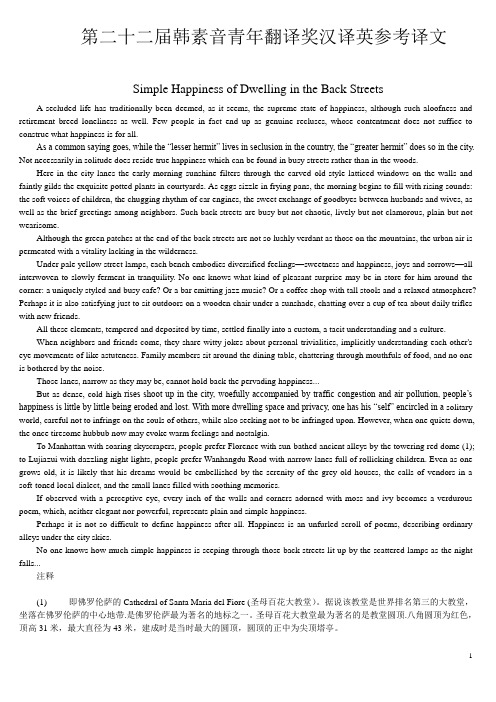
第二十二届韩素音青年翻译奖汉译英参考译文Simple Happiness of Dwelling in the Back StreetsA secluded life has traditionally been deemed, as it seems, the supreme state of happiness, although such aloofness and retirement breed loneliness as well. Few people in fact end up as genuine recluses, whose contentment does not suffice to construe what happiness is for all.As a common saying goes, while the “lesser hermit” lives in seclusion in the country, the “greater hermit” does so in the cit y. Not necessarily in solitude does reside true happiness which can be found in busy streets rather than in the woods.Here in the city lanes the early morning sunshine filters through the carved old-style latticed windows on the walls and faintly gilds the exquisite potted plants in courtyards. As eggs sizzle in frying pans, the morning begins to fill with rising sounds: the soft voices of children, the chugging rhythm of car engines, the sweet exchange of goodbyes between husbands and wives, as well as the brief greetings among neighbors. Such back streets are busy but not chaotic, lively but not clamorous, plain but not wearisome.Although the green patches at the end of the back streets are not so lushly verdant as those on the mountains, the urban air is permeated with a vitality lacking in the wilderness.Under pale yellow street lamps, each bench embodies diversified feelings—sweetness and happiness, joys and sorrows—all interwoven to slowly ferment in tranquility. No one knows what kind of pleasant surprise may be in store for him around the corner: a uniquely styled and busy cafe? Or a bar emitting jazz music? Or a coffee shop with tall stools and a relaxed atmosphere? Perhaps it is also satisfying just to sit outdoors on a wooden chair under a sunshade, chatting over a cup of tea about daily trifles with new friends.All these elements, tempered and deposited by time, settled finally into a custom, a tacit understanding and a culture.When neighbors and friends come, they share witty jokes about personal trivialities, implicitly understanding each other's eye movements of like astuteness. Family members sit around the dining table, chattering through mouthfuls of food, and no one is bothered by the noise.Those lanes, narrow as they may be, cannot hold back the pervading happiness...But as dense, cold high-rises shoot up in the city, woefully accompanied by traffic congestion and air pollution, people’s happiness is little by little being eroded and lost. With more dwelling space and privacy, one has his “self” encircled in a solitary world, careful not to infringe on the souls of others, while also seeking not to be infringed upon. However, when one quiets dow n, the once tiresome hubbub now may evoke warm feelings and nostalgia.To Manhattan with soaring skyscrapers, people prefer Florence with sun-bathed ancient alleys by the towering red dome (1); to Lujiazui with dazzling night lights, people prefer Wanhangdu Road with narrow lanes full of rollicking children. Even as one grows old, it is likely that his dreams would be embellished by the serenity of the grey old houses, the calls of vendors in a soft-toned local dialect, and the small lanes filled with soothing memories.If observed with a perceptive eye, every inch of the walls and corners adorned with moss and ivy becomes a verdurous poem, which, neither elegant nor powerful, represents plain and simple happiness.Perhaps it is not so difficult to define happiness after all. Happiness is an unfurled scroll of poems, describing ordinary alleys under the city skies.No one knows how much simple happiness is seeping through those back streets lit up by the scattered lamps as the night falls...注释(1) 即佛罗伦萨的Cathedral of Santa Maria del Fiore (圣母百花大教堂)。
2022韩素音国际翻译大赛(英译汉)二等奖译文
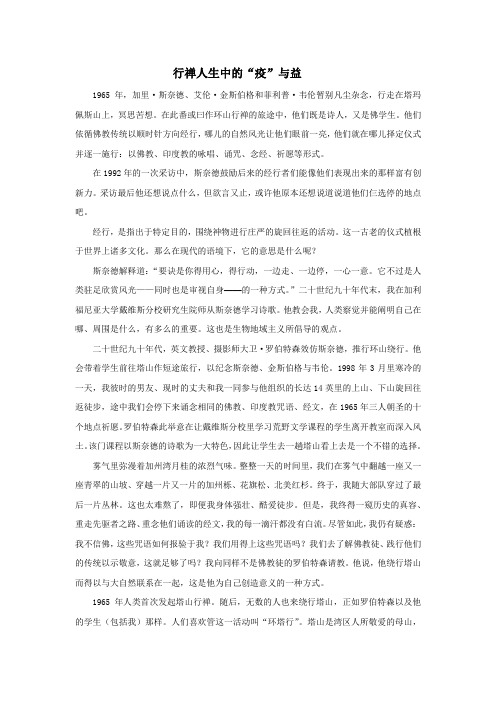
行禅人生中的“疫”与益1965年,加里·斯奈德、艾伦·金斯伯格和菲利普·韦伦暂别凡尘杂念,行走在塔玛佩斯山上,冥思苦想。
在此番或曰作环山行禅的旅途中,他们既是诗人,又是佛学生。
他们依循佛教传统以顺时针方向经行,哪儿的自然风光让他们眼前一亮,他们就在哪儿择定仪式并逐一施行:以佛教、印度教的咏唱、诵咒、念经、祈愿等形式。
在1992年的一次采访中,斯奈德鼓励后来的经行者们能像他们表现出来的那样富有创新力。
采访最后他还想说点什么,但欲言又止,或许他原本还想说道说道他们仨选停的地点吧。
经行,是指出于特定目的,围绕神物进行庄严的旋回往返的活动。
这一古老的仪式植根于世界上诸多文化。
那么在现代的语境下,它的意思是什么呢?斯奈德解释道:“要诀是你得用心,得行动,一边走、一边停,一心一意。
它不过是人类驻足欣赏风光——同时也是审视自身——的一种方式。
”二十世纪九十年代末,我在加利福尼亚大学戴维斯分校研究生院师从斯奈德学习诗歌。
他教会我,人类察觉并能阐明自己在哪、周围是什么,有多么的重要。
这也是生物地域主义所倡导的观点。
二十世纪九十年代,英文教授、摄影师大卫·罗伯特森效仿斯奈德,推行环山绕行。
他会带着学生前往塔山作短途旅行,以纪念斯奈德、金斯伯格与韦伦。
1998年3月里寒冷的一天,我彼时的男友、现时的丈夫和我一同参与他组织的长达14英里的上山、下山旋回往返徒步,途中我们会停下来诵念相同的佛教、印度教咒语、经文,在1965年三人朝圣的十个地点祈愿。
罗伯特森此举意在让戴维斯分校里学习荒野文学课程的学生离开教室而深入风土。
该门课程以斯奈德的诗歌为一大特色,因此让学生去一趟塔山看上去是一个不错的选择。
雾气里弥漫着加州湾月桂的浓烈气味。
整整一天的时间里,我们在雾气中翻越一座又一座青翠的山坡、穿越一片又一片的加州栎、花旗松、北美红杉。
终于,我随大部队穿过了最后一片丛林。
这也太难熬了,即便我身体强壮、酷爱徒步。
历届韩素音翻译大奖赛竞赛原文及译文
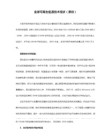
历届韩素音翻译大奖赛竞赛原文及译文英译汉部分 (3)Beauty (excerpt) (3)美(节选) (3)The Literature of Knowledge and the Literature of Power byThomas De Quincey (8)知识文学与力量文学托马斯.昆西 (8)An Experience of Aesthetics by Robert Ginsberg (11)审美的体验罗伯特.金斯伯格 (11)A Person Who Apologizes Has the Moral Ball in His Court by Paul Johnson (14)谁给别人道歉,谁就在道义上掌握了主动保罗.约翰逊 (14)On Going Home by Joan Didion (18)回家琼.狄迪恩 (18)The Making of Ashenden (Excerpt) by Stanley Elkin (22)艾兴登其人(节选)斯坦利.埃尔金 (22)Beyond Life (28)超越生命[美] 卡贝尔著 (28)Envy by Samuel Johnson (33)论嫉妒[英]塞缪尔.约翰逊著 (33)中译英部分 (37)在义与利之外 (37)Beyond Righteousness and Interests (37)读书苦乐杨绛 (40)The Bitter-Sweetness of Reading Yang Jiang (40)想起清华种种王佐良 (43)Reminiscences of Tsinghua Wang Zuoliang (43)歌德之人生启示宗白华 (45)What Goethe's Life Reveals by Zong Baihua (45)怀想那片青草地赵红波 (48)Yearning for That Piece of Green Meadow by Zhao Hongbo (48)可爱的南京 (51)Nanjing the Beloved City (51)霞冰心 (53)The Rosy Cloud byBingxin (53)黎明前的北平 (54)Predawn Peiping (54)老来乐金克木 (55)Delights in Growing Old by Jin Kemu (55)可贵的“他人意识” (58)Calling for an Awareness of Others (58)教孩子相信 (61)To Implant In Our Children’s Young Hearts An Undying Faith In Humanity (61)英译汉部分Beauty (excerpt)美(节选)Judging from the scientists I know, including Eva and Ruth, and those whom I've read about, you can't pursue the laws of nature very long without bumping撞倒; 冲撞into beauty. “I don't know if it's the same beauty you see in the sunset,”a friend tells me, “but it feels the same.”This friend is a physicist, who has spent a long career deciphering破译(密码), 辨认(潦草字迹) what must be happening in the interior of stars. He recalls for me this thrill on grasping for the first time Dirac's⑴equations describing quantum mechanics, or those of Einstein describing relativity. “They're so beautiful,” he says, “you can see immediately they have to be true. Or at least on the way toward truth.” I ask him what makes a theory beautiful, and he replies, “Si mplicity, symmetry .对称(性); 匀称, 整齐, elegance, and power.”我结识一些科学家(包括伊娃和露丝),也拜读过不少科学家的著作,从中我作出推断:人们在探求自然规律的旅途中,须臾便会与美不期而遇。
第二十二届韩素音青年翻译奖竟赛英译汉译文和译文评析

英译汉Hidden Within Technology’s Empire, a Republic of Letters隐藏于技术帝国的文学界索尔•贝妻When I was a boy “discovering literature”, I used to think how wonderful it would be if every other person on the street were familiar with Proust and Joyce or T. E. Lawrence or Pasternak and Kafka. Later I learned how refractory to high culture the democratic masses were. Lincoln as a young frontiersman read Plutarch, Shakespeare and the Bible. But then he was Lincoln.我还是个"探索文学"的少年时,就经常在想:要是大街上人人都熟悉普鲁斯特和乔伊斯,熟悉T.E.劳伦斯,熟悉帕斯捷尔纳克和卡夫卡,该有多好啊!后来才知道,平民百姓对高雅文化有多排斥。
虽说少年时代身居边陲的林肯就在阅读普鲁塔克,、莎士比亚和《圣经》,但他毕竟是林肯。
Later when I was traveling in the Midwest by car, bus and train, I regularly visited small-town libraries and found that readers in Keokuk, Iowa, or Benton Harbor, Mich., were checking out Proust and Joyce and even Svevo and Andrei Biely. D. H. Lawrence was also a favorite. And sometimes I remembered that God was willing to spare Sodom for the sake of 10 of the righteous. Not that Keokuk was anything like wicked Sodom, or that Proust’s Charlus would have been tempted to settle in Benton Harbor, Mich. I seem to have had a persistent democratic desire to find evidences of high culture in the most unlikely places.后来,我坐小车、巴士和火车在中西部旅行,经常走访小镇图书馆;发现在衣阿华州基奥卡克市,或者密歇根州本顿港市,读者们借阅普鲁斯特和乔伊斯的作品,甚至还有斯维沃@和安德烈•别雷®的著作。
24届韩素音青年翻译奖汉译英

Language and Social StatusOne's language is inseparable from the its identity in the society. I still remembered that a neighbour got up early to practice the pronunciation everyday in order to make his sounds euphonic, when I lived in Australia.Indeed, the language is the sign of one's social status, especially in the multi-national and multi-cultural society. The so-called "identity", is also a kind of knowledge structure, indicating the cultural background of the social group where you come from, the knowledge degree and even the geographical position.The language will influence the corresponding cultural cognition. For example, the research finds that, for the bilingual chinese, when asked about the cultural concepts in chinese, their answers are more apparent to reveal the chinese styles than asked such problems in English. Interestingly, when Hong Kong and Macao people who speak cantonese are asked about china's culture and religion in mandarin, their answers are always more close to the ways of westerners express than in cantonese with the same questions.In fact, for the chinese learning foreign languages, the majority are not the real sense of so-called "bilingual people", but "bilingual users"; The latter is in the language and the expression level, but the former is in thinking and life habits. However, this process is not still, but can be converted.Therefore, the study of language learners, is in fact a kind of social relations, which he understands and forms across the space and time.Thus, he faces is not only the linguistics, but the multiple, changing social status.Research also shows that a person's speech style is not aptotic, but it will change as the changes of the social environment and the people he talks to. In general, the personal speech has a tendency to convergence (that is, follow the crowd), but sometimes it also have divergent tendency (that is to show their own characteristics). For example, when I went back to Beijing, my "Beijing tone" becomes strong a lot; And when my English friends in Australia, his "anglicisms" remains more apparent. I don't know whether it is deliberately to show its identity.During the process of people adapting to the exotic culture, his attitudes to thenative language also have a positive or negative choices. Some people, when they are active in the other mainstream cultures at the same time, they are inclined to weaken their own native language ability; However, some people, strengthen this aspect, thinking this is an advantage.Generally speaking, if the language that a certain social groups speak is for some kind of social respect(such as in England, the language spoken the noble as a representative of the queen.),it will have a higher social superiority. And its members also might show distinvtive, in order to keep with its positive group characteristics. Of course, it is inevitable to have others draw close way of speaking to this group.A man's language also can become the evaluation of other objects. According to the research, people can judge his social position, education level, kind or not, intelligence, ability and even wealth from the language and so on.Visibly, language has the meaning to the individual. If the clothing is the body's modification, then the language is the external expression of one's comprehensive value. Therefore, the language should not only be regarded as a tool, but a kind of quality.。
第22届韩素音翻译大赛 英译汉 参考译文
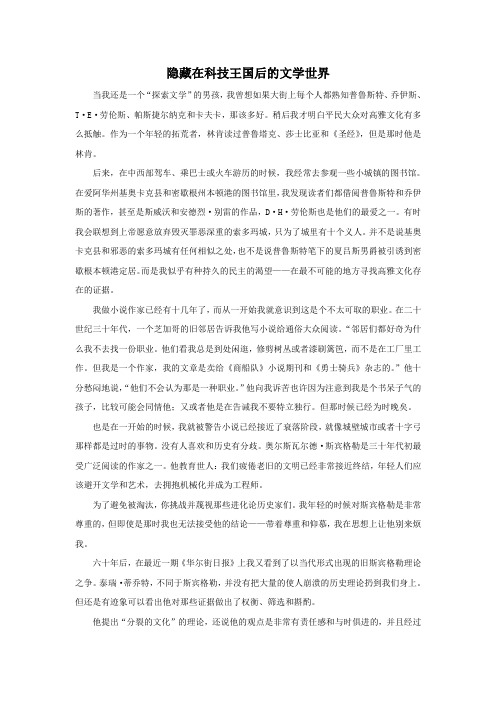
隐藏在科技王国后的文学世界当我还是一个“探索文学”的男孩,我曾想如果大街上每个人都熟知普鲁斯特、乔伊斯、T·E·劳伦斯、帕斯捷尔纳克和卡夫卡,那该多好。
稍后我才明白平民大众对高雅文化有多么抵触。
作为一个年轻的拓荒者,林肯读过普鲁塔克、莎士比亚和《圣经》,但是那时他是林肯。
后来,在中西部驾车、乘巴士或火车游历的时候,我经常去参观一些小城镇的图书馆。
在爱阿华州基奥卡克县和密歇根州本顿港的图书馆里,我发现读者们都借阅普鲁斯特和乔伊斯的著作,甚至是斯威沃和安德烈·别雷的作品,D·H·劳伦斯也是他们的最爱之一。
有时我会联想到上帝愿意放弃毁灭罪恶深重的索多玛城,只为了城里有十个义人。
并不是说基奥卡克县和邪恶的索多玛城有任何相似之处,也不是说普鲁斯特笔下的夏吕斯男爵被引诱到密歇根本顿港定居。
而是我似乎有种持久的民主的渴望——在最不可能的地方寻找高雅文化存在的证据。
我做小说作家已经有十几年了,而从一开始我就意识到这是个不太可取的职业。
在二十世纪三十年代,一个芝加哥的旧邻居告诉我他写小说给通俗大众阅读。
“邻居们都好奇为什么我不去找一份职业。
他们看我总是到处闲逛,修剪树丛或者漆刷篱笆,而不是在工厂里工作。
但我是一个作家,我的文章是卖给《商船队》小说期刊和《勇士骑兵》杂志的。
”他十分愁闷地说,“他们不会认为那是一种职业。
”他向我诉苦也许因为注意到我是个书呆子气的孩子,比较可能会同情他;又或者他是在告诫我不要特立独行。
但那时候已经为时晚矣。
也是在一开始的时候,我就被警告小说已经接近了衰落阶段,就像城壁城市或者十字弓那样都是过时的事物。
没有人喜欢和历史有分歧。
奥尔斯瓦尔德·斯宾格勒是三十年代初最受广泛阅读的作家之一。
他教育世人:我们疲倦老旧的文明已经非常接近终结,年轻人们应该避开文学和艺术,去拥抱机械化并成为工程师。
为了避免被淘汰,你挑战并蔑视那些进化论历史家们。
2021韩素音英译汉译文
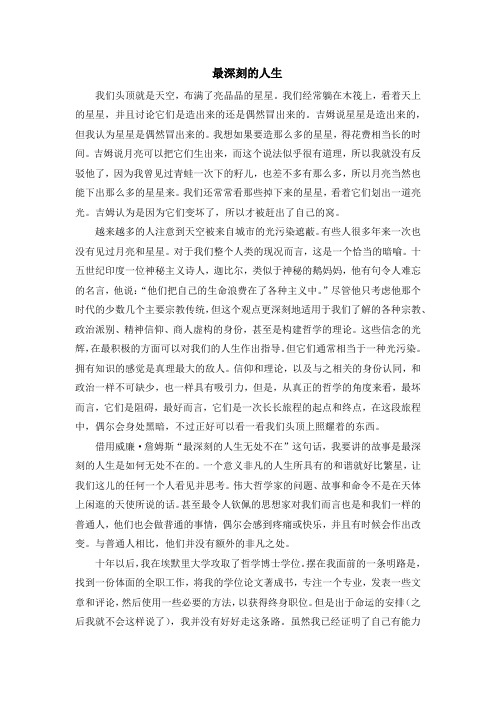
最深刻的人生我们头顶就是天空,布满了亮晶晶的星星。
我们经常躺在木筏上,看着天上的星星,并且讨论它们是造出来的还是偶然冒出来的。
吉姆说星星是造出来的,但我认为星星是偶然冒出来的。
我想如果要造那么多的星星,得花费相当长的时间。
吉姆说月亮可以把它们生出来,而这个说法似乎很有道理,所以我就没有反驳他了,因为我曾见过青蛙一次下的籽儿,也差不多有那么多,所以月亮当然也能下出那么多的星星来。
我们还常常看那些掉下来的星星,看着它们划出一道亮光。
吉姆认为是因为它们变坏了,所以才被赶出了自己的窝。
越来越多的人注意到天空被来自城市的光污染遮蔽。
有些人很多年来一次也没有见过月亮和星星。
对于我们整个人类的现况而言,这是一个恰当的暗喻。
十五世纪印度一位神秘主义诗人,迦比尔,类似于神秘的鹅妈妈,他有句令人难忘的名言,他说:“他们把自己的生命浪费在了各种主义中。
”尽管他只考虑他那个时代的少数几个主要宗教传统,但这个观点更深刻地适用于我们了解的各种宗教、政治派别、精神信仰、商人虚构的身份,甚至是构建哲学的理论。
这些信念的光辉,在最积极的方面可以对我们的人生作出指导。
但它们通常相当于一种光污染。
拥有知识的感觉是真理最大的敌人。
信仰和理论,以及与之相关的身份认同,和政治一样不可缺少,也一样具有吸引力,但是,从真正的哲学的角度来看,最坏而言,它们是阻碍,最好而言,它们是一次长长旅程的起点和终点,在这段旅程中,偶尔会身处黑暗,不过正好可以看一看我们头顶上照耀着的东西。
借用威廉·詹姆斯“最深刻的人生无处不在”这句话,我要讲的故事是最深刻的人生是如何无处不在的。
一个意义非凡的人生所具有的和谐就好比繁星,让我们这儿的任何一个人看见并思考。
伟大哲学家的问题、故事和命令不是在天体上闲逛的天使所说的话。
甚至最令人钦佩的思想家对我们而言也是和我们一样的普通人,他们也会做普通的事情,偶尔会感到疼痛或快乐,并且有时候会作出改变。
与普通人相比,他们并没有额外的非凡之处。
忠实通顺传神——从二十二届韩素英青年翻译大赛看文学翻译标准
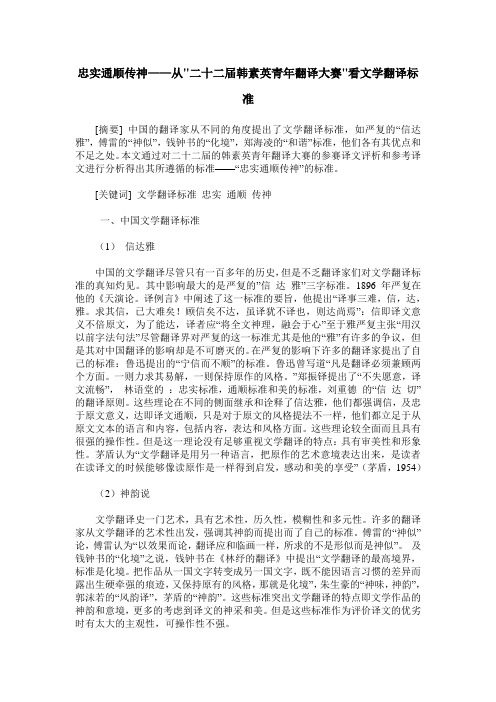
忠实通顺传神——从"二十二届韩素英青年翻译大赛"看文学翻译标准[摘要] 中国的翻译家从不同的角度提出了文学翻译标准,如严复的“信达雅”,傅雷的“神似”,钱钟书的“化境”,郑海凌的“和谐”标准,他们各有其优点和不足之处。
本文通过对二十二届的韩素英青年翻译大赛的参赛译文评析和参考译文进行分析得出其所遵循的标准——“忠实通顺传神”的标准。
[关键词] 文学翻译标准忠实通顺传神一、中国文学翻译标准(1)信达雅中国的文学翻译尽管只有一百多年的历史,但是不乏翻译家们对文学翻译标准的真知灼见。
其中影响最大的是严复的”信达雅”三字标准。
1896年严复在他的《天演论。
译例言》中阐述了这一标准的要旨,他提出“译事三难,信,达,雅。
求其信,已大难矣!顾信矣不达,虽译犹不译也,则达尚焉”:信即译文意义不倍原文,为了能达,译者应“将全文神理,融会于心”至于雅严复主张“用汉以前字法句法”尽管翻译界对严复的这一标准尤其是他的“雅”有许多的争议,但是其对中国翻译的影响却是不可磨灭的。
在严复的影响下许多的翻译家提出了自己的标准:鲁迅提出的“宁信而不顺”的标准。
鲁迅曾写道“凡是翻译必须兼顾两个方面。
一则力求其易解,一则保持原作的风格。
”郑振铎提出了“不失愿意,译文流畅”,林语堂的:忠实标准,通顺标准和美的标准,刘重德的“信达切”的翻译原则。
这些理论在不同的侧面继承和诠释了信达雅,他们都强调信,及忠于原文意义,达即译文通顺,只是对于原文的风格提法不一样,他们都立足于从原文文本的语言和内容,包括内容,表达和风格方面。
这些理论较全面而且具有很强的操作性。
但是这一理论没有足够重视文学翻译的特点:具有审美性和形象性。
茅盾认为“文学翻译是用另一种语言,把原作的艺术意境表达出来,是读者在读译文的时候能够像读原作是一样得到启发,感动和美的享受”(茅盾,1954)(2)神韵说文学翻译史一门艺术,具有艺术性,历久性,模糊性和多元性。
韩素音英译汉原文
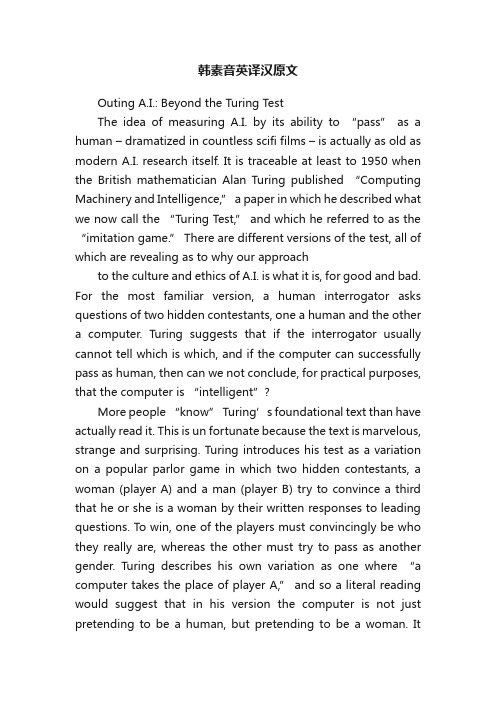
韩素音英译汉原文Outing A.I.: Beyond the Turing TestThe idea of measuring A.I. by its ability to “pass” as a human – dramatized in countless scifi films – is actually as old as modern A.I. research itself. It is traceable at least to 1950 when the British mathematician Alan Turing published “Computing Machinery and Intelligence,” a paper in which he described what we now call the “Turing Test,” and which he referred to as the “imitation game.” There are different versions of the test, all of which are revealing as to why our approachto the culture and ethics of A.I. is what it is, for good and bad. For the most familiar version, a human interrogator asks questions of two hidden contestants, one a human and the other a computer. Turing suggests that if the interrogator usually cannot tell which is which, and if the computer can successfully pass as human, then can we not conclude, for practical purposes, that the computer is “intelligent”?Mor e people “know” Turing’s foundational text than have actually read it. This is un fortunate because the text is marvelous, strange and surprising. Turing introduces his test as a variation on a popular parlor game in which two hidden contestants, a woman (player A) and a man (player B) try to convince a third that he or she is a woman by their written responses to leading questions. To win, one of the players must convincingly be who they really are, whereas the other must try to pass as another gender. Tur ing describes his own variation as one where “a computer takes the place of player A,” and so a literal reading would suggest that in his version the computer is not just pretending to be a human, but pretending to be a woman. Itmust pass as a she.Passing as a person comes down to what others see and interpret. Because everyone else is already willing to read others according to conventional cues (of race, sex, gender, species, etc.) the complicity between whoever (or whatever) is passing and those among which he or she or it performs is what allows passing to succeed. Whether or not an A.I. is trying to pass as a human or is merely in drag as a human is another matter. Is the ruse all just a game or, as for some people who are compelled to pass in their daily lives, an essential camouflage? Either way, “passing” may say more about the audience than about the performers.That we would wish to define the very existence of A.I. in relation to its ability to mimic how humans think that humans think will be looked back upon as a weird sort of speciesism. The legacy of that conceit helped to steer some older A.I. research down disappointingly fruitless paths, hoping to recreate human minds from available parts. It just doesn’t work that way. ContemporaryA.I. research suggests instead that the threshold by which any particular arrangement of matter can be said to be “intelligent” doesn’t have much to do with how it reflects humanness back at us. As Stuart Russell and Peter Norvig (now director of research at Google) suggest in their essential A.I. textbook, biomorphic imitation is not how we design complex technology. Airplanes don’t fly like birds fly, and we certainly don’t try to trick birds into thinking that airplanes are birds in order to test whether those p lanes “really” are flying machines. Why do it for A.I. then? Today’s serious A.I. research does not focus on the Turing Test as an objective criterion of success, andyet in our popular culture of A.I., the test’s anthropocentrism holds such durable conceptual importance. Like the animals who talk like teenagers in a Disney movie, other minds are conceivable mostly by way of puerile ventriloquism.Where is the real injury in this? If we want everyday A.I. to be congenial in a humane sort of way, so what? The answer is that we have much to gain from a more sincere and disenchanted relationship to synthetic intelligences, and much to lose by keeping illusions on life support. Some philosophers write about the possible ethical “rights” of A.I. as sentient entit ies, but that’s not my point here. Rather, the truer perspective is also the better one for us as thinking technical creatures.Musk, Gates and Hawking made headlines by speaking to the dangers that A.I. may pose. Their points are important, but I fear were largely misunderstood by many readers. Relying on efforts to program A.I. not to “harm humans” (inspired by Isaac Asimov’s “three laws” of robotics from 1942) makes sense only when an A.I. knows what humans are and what harming them might mean. There are many ways that an A.I. might harm us that have nothing to do with its malevolence toward us, and chief among these is exactly following our well-meaning instructions to an idiotic and catastrophic extreme. Instead of mechanical failure or a transgression of moral code, the A.I. may pose an existential risk because it is both powerfully intelligent and disinterested in humans. T o the extent that we recognize A.I. by its anthropomorphic qualities, or presume its preoccupation with us, we are vulnerable to those eventualities.Whether or not “hard A.I.” ever appears, the harm is al so in the loss of all that we prevent ourselves from discovering and understanding when we insist on protecting beliefs we know tobe false. In the 1950 essay, Turing offers several rebuttals to his speculative A.I., including a striking comparison with earlier objections to Copernican astronomy. Copernican traumas that abolish the false centrality and absolute specialness of human thought and species-being are pricelessaccomplishments. They allow for human culture based on how the world actually is more than on how it appears to us from our limited vantage point. Turing referred to these as “theological objections,” but one could argue that the anthropomorphic precondition for A.I. is a“pre-Copernican” attitude as well, however secular it may appear. The advent of robust inhuman A.I. may let us achieve another disenchantment, one that should enable a more reality-based understanding of ourselves, our situation, and a fuller and more complex understanding of what “intelligence” is and is not. From there we can hopefully make our world with a greater confidence that our models are good approximations of what’s out there.。
韩素音翻译原文(1)
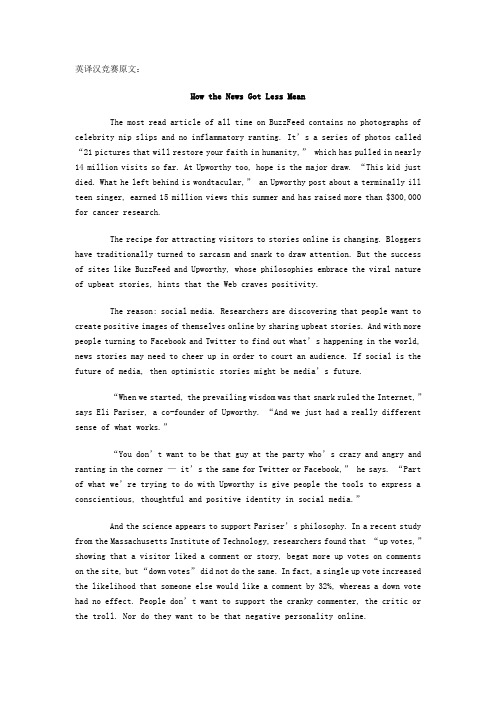
英译汉竞赛原文:How the News Got Less MeanThe most read article of all time on BuzzFeed contains no photographs of celebrity nip slips and no inflammatory ranting. It’s a series of photos called “21 pictures that will restore your faith in humanity,” which has pulled in nearly 14 million visits so far. At Upworthy too, hope is the major draw. “This kid just died. What he left behind is wondtacular,” an Upworthy post about a terminally ill teen singer, earned 15 million views this summer and has raised more than $300,000 for cancer research.The recipe for attracting visitors to stories online is changing. Bloggers have traditionally turned to sarcasm and snark to draw attention. But the success of sites like BuzzFeed and Upworthy, whose philosophies embrace the viral nature of upbeat stories, hints that the Web craves positivity.The reason: social media. Researchers are discovering that people want to create positive images of themselves online by sharing upbeat stories. And with more people turning to Facebook and Twitter to find out what’s happening in the world, news stories may need to cheer up in order to court an audience. If social is the future of media, then optimistic stories might be media’s future.“When we started, the prevailing wisdom was that snark ruled the Internet,”says Eli Pariser, a co-founder of Upworthy. “And we just had a really different sense of what works.”“You don’t want to be that guy at the party who’s crazy and angry and ranting in the corner — it’s the same for Twitter or Facebook,” he says. “Part of what we’re trying to do with Upworthy is give people the tools to express a conscientious, thoughtful and positive identity in social media.”And the science appears to support Pariser’s philosophy. In a recent study from the Massachusetts Institute of Technology, researchers found that “up votes,”showing that a visitor liked a comment or story, begat more up votes on comments on the site, but “down votes” did not do the same. In fact, a single up vote increased the likelihood that someone else would like a comment by 32%, whereas a down vote had no effect. People don’t want to support the cranky commenter, the critic or the troll. Nor do they want to be that negative personality online.In another study published in 2012, Jonah Berger, author of Contagious: Why Things Catch On and professor of marketing at the Wharton School of the University of Pennsylvania, monitored the most e-mailed stories produced by the New York Times for six months and found that positive stories were more likely to make the list than negative ones.“What we share [or like] is almost like the car we drive or the clothes we wear,”he says. “It says something about us to other people. So people would much rather be seen as a Positive Polly than a Debbie Downer.”It’s not always that simple: Berger says that though positive pieces drew more traffic than negative ones, within the categories of positive and negative stories, those articles that elicited more emotion always led to more shares.“Take two negative emotions, for example: anger and sadness,” Berger says. “Both of those emotions would make the reader feel bad. But anger, a high arousal emotion, leads to more sharing, whereas sadness, a low arousal emotion, doesn’t. The same is true of the positive side: excitement and humor increase sharing, whereas contentment decreases sharing.”And while some popular BuzzFeed posts — like the recent “Is this the most embarrassing interview Fox News has ever done?”— might do their best to elicit shares through anger, both BuzzFeed and Upworthy recognize that their main success lies in creating positive viral material.“It’s not that people don’t share negative stories,” says Jack Shepherd, editorial director at BuzzFeed. “It just means that there’s a higher potential for positive stories to do well.”Upworthy’s mission is to highlight serious issues but in a hopeful way, encouraging readers to donate money, join organizations and take action. The strategy seems to be working: barely two years after its launch date (in March 2012), the site now boasts 30 million unique visitors per month, according to Upworthy. The site’s average monthly unique visitors grew to 14 million people over its first six quarters — to put that in perspective, the Huffington Post had only about 2 million visitors in its first six quarters online.But Upworthy measures the success of a story not just by hits. The creators of the site only consider a post a success if it’s also shared frequently on social media. “We are interested in content that people want to share partly for pragmaticreasons,” Pariser says. “If you don’t have a good theory about how to appear in Facebook and Twitter, then you may disappear.”Nobody has mastered the ability to make a story go viral like BuzzFeed. The site, which began in 2006 as a lab to figure out what people share online, has used what it’s learned to draw 60 million monthly unique visitors, according to BuzzFeed. (Most of that traffic comes from social-networking sites, driving readers toward BuzzFeed’s mix of cute animal photos and hard news.) By comparison the New York Times website, one of the most popular newspaper sites on the Web, courts only 29 million unique visitors each month, according to the Times.BuzzFeed editors have found that people do still read negative or critical stories, they just aren’t the posts they share with their friends. And those shareable posts are the ones that newsrooms increasingly prize.“Anecdotally, I can tell you people are just as likely to click on negative stories as they are to click on positive ones,” says Shepherd. “But they’re more likely to share positive stories. What you’re interested in is different from what you want your friends to see what you’re interested in.”So as newsrooms re-evaluate how they can draw readers and elicit more shares on Twitter and Facebook, they may look to BuzzFeed’s and Upworthy’s happiness model for direction.“I think that the Web is only becoming more social,” Shepherd says. “We’re at a point where readers are your publishers. If news sites aren’t thinking about what it would mean for someone to share a story on social media, that could be detrimental.”汉译英竞赛原文:城市的迷失沿着瑗珲—腾冲线,这条1935年由胡焕庸先生发现并命名的中国人口、自然和历史地理的分界线,我们看到,从远距离贸易发展开始的那天起,利益和权力的渗透与分散,已经从根本结构上改变了城市的状态:城市在膨胀,人在疏离。
第十二届“韩素音青年翻译奖”竞赛原文及参考译文(汉译英)
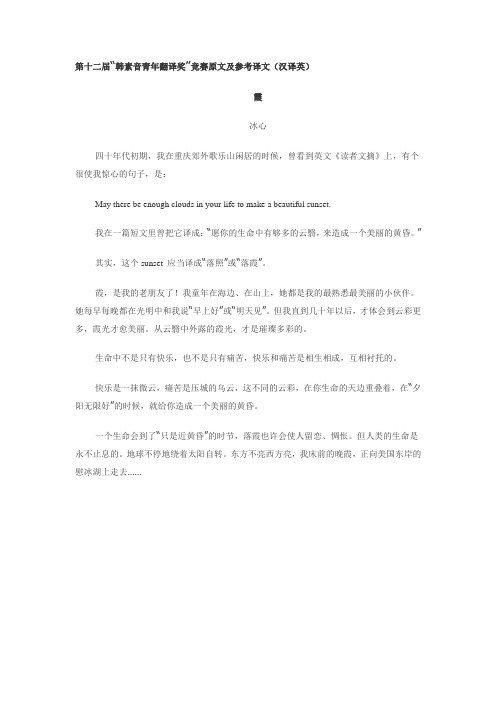
第十二届“韩素音青年翻译奖”竞赛原文及参考译文(汉译英)霞冰心四十年代初期,我在重庆郊外歌乐山闲居的时候,曾看到英文《读者文摘》上,有个很使我惊心的句子,是:May there be enough clouds in your life to make a beautiful sunset.我在一篇短文里曾把它译成:“愿你的生命中有够多的云翳,来造成一个美丽的黄昏。
”其实,这个sunset 应当译成“落照”或“落霞”。
霞,是我的老朋友了!我童年在海边、在山上,她都是我的最熟悉最美丽的小伙伴。
她每早每晚都在光明中和我说“早上好”或“明天见”。
但我直到几十年以后,才体会到云彩更多,霞光才愈美丽。
从云翳中外露的霞光,才是璀璨多彩的。
生命中不是只有快乐,也不是只有痛苦,快乐和痛苦是相生相成,互相衬托的。
快乐是一抹微云,痛苦是压城的乌云,这不同的云彩,在你生命的天边重叠着,在“夕阳无限好”的时候,就给你造成一个美丽的黄昏。
一个生命会到了“只是近黄昏”的时节,落霞也许会使人留恋、惆怅。
但人类的生命是永不止息的。
地球不停地绕着太阳自转。
东方不亮西方亮,我床前的晚霞,正向美国东岸的慰冰湖上走去……The Rosy CloudBingxinDuring the early 1940s I was living a retired life in the Gele Mountains in the suburbs of Chongqing (Chungking). One day, while reading the English language magazine Reader's Digest I found a sentence that touched me greatly. It read: "May there be enough clouds in your life to make a beautiful sunset."In a short article of mine, I quoted this sentence and translated it as "Yuan ni de shengming zhong you guo duo de yunyi, lai zaocheng yige meili de huanghun. " (literally: May there be enough clouds in your life to make a beautiful sunset.) *As I see it now, the word "sunset" in the English sentence should have been translated as luozhao (the glow at sunset) or luoxia (the rosy cloud at sunset), instead of dusk.She has been my dear old friend, the Rosy Cloud! She was my closest and most beautiful little companion when, in my childhood, I played on the beach or in the hills. Bathed in the brilliant sunshine, she would say to me "Good morning!" at dawn and "See you tomorrow!" at dusk. But not until several decades later did I come to realize that the more clouds there are the more beautiful the rays of sunlight will be, and the glow of the sun breaking through the clouds becomes most resplendent and colorful.Life contains neither unalloyed happiness nor mere misery. Happiness and misery beget, complement and set off each other.Happiness is a wisp of fleecy cloud; misery a mass of threatening dark cloud. These different clouds overlap on the horizon of your life to create a beautiful dusk for you when "the setting sun is most lovely indeed."**An individual's life must inevitably reach the point when "dusk is so near,"*** and the rosy sunset cloud may make one nostalgic and melancholy. But human life goes on and on. The Earth ceaselessly rotates on its axis around the sun. When it is dark in the east, it is light in the west. The rosy sunset cloud is now sailing past my window towards Lake Waban on the east coast of America ...*This sentence appears in Chinese and English in the article "For Young Readers Again, Newsletter No.4", written by Bing Xin in the Gele Mountains, on December 1, 1944.** and *** These two poetic lines are taken from a poem "On the Plain of Tombs" by Li Shangyin (813-858), a well-known poet of the Tang Dynasty (618-907). The two lines read like this: "The setting sun appears sublime, / But O! 'Tis near its dying time." (Tr. Xu Yuanchong) They imply that the setting sun has infinite beauty, but it is a pity that it is near the dusk, and the beautiful scene cannot last long. The two lines are often used to deplore the ephemeral nature of things, and to express the feelings at the loss of past glory and at the advent of old age.。
韩素音译文

恰逢其时:对“临时性”的再考量我们往往会认为建筑物就该是永久性的,甚至希望达到与纪念碑相提并论的地位。
此类建筑固然占有一席之地,但另一类建筑同样有其存在的价值。
在21世纪头十年的大部分时间里,建筑艺术就是要使建筑物起到某种昭示作用。
无论是颇具争议的纪念碑,还是奢华程度令人难以想象的公寓大厦,建筑存在的理由就是要给人留下难以磨灭的印象。
建筑从来就是“永久性”的同义词,但是,它果真应该是如此吗?在过去的几年中,实际情形也许恰恰相反。
建筑业的经济效益可以说是空气的不景气,承担大型建筑项目的机会寥寥无几,而那些备受媒体瞩目的建筑也是来去匆匆,像游击商店、食品车、市场、演出场地等。
虽然许多此类风格的建筑早已成明日黄花(如玩具“反”斗游击店),但临时性建筑的机遇是不可否认的:这是对日新月异的文明现象的恰当回应。
就如同合作消费(或“分享制”)、社区田园、易物交易等许多流行的做法那样,“临时性”建筑如此趋于回归,俨然非同一般,令人刮目相看。
我有幸在11月份同罗伯特·克罗能伯格(Robert Kronenburg)一道主持了南加州大学建筑学院的“移动乌托邦”小型研讨会。
克罗能伯格是一名建筑师,利物浦大学的教授,是研究便携式、临时性、移动型建筑的权威人士。
他在该领域著作等身,其中有《变通性:应对变化的建筑风格》,《便携式建筑:设计与技术》,《移动房屋的起源》,可谓浸淫其中。
克罗能伯格认为,可移动性有一种内在的生发力。
既然可移动的环境要比静止的更具有活力,为什么建筑物就非得静止不动呢?或许并非所有的建筑物都应追求永恒,这一观点标志着建筑设计的巨大转变。
摆脱了传统的束缚,建筑师、设计师、建造者和开发商就能更快地利用当前新技术之长,并付诸实施。
建筑是可再利用,可循环,可持续的。
以此方式重新定位和着手,一些看似解决不了的问题就可能迎刃而解,这样的建筑物仍能给人们带来身临实地的感觉。
克罗能伯格发言时举例说明了便携式、临时性的建筑早已运用于人类活动的各个方面,包括医疗(从弗罗伦斯·南丁格尔重新设计的医院到肯尼迪执政期间被用作流动医疗诊所的“清风”拖挂房车等)、住房(从蒙古包到帐篷,再到建筑师坂茂设计的震后纸板房),还有文化与商业(如各种舞台布景、万国工业博览会的各种建筑、塞纳河畔的那些百年流动旧书摊、移动餐饮店、艺术与音乐场所,这些场所提供各种商品,从录音故事到可口的焦糖奶油布丁,一应俱全)。
准确理解审慎表达_第十二届_韩素音青年翻译奖_英译汉参赛译文评析
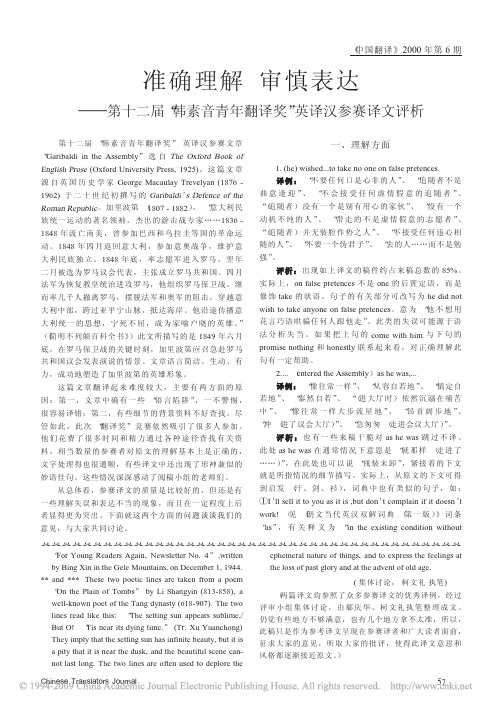
“ 不要任何口是心非的人” 、 “ 追随者不是 曲意逢迎” 、 “ 不会接受任何虚情假意的追随者” 、 “ ( 追随者)没有一个 是 别 有 用 心 的 家 伙 ” 、 “ 没有一个 动机不纯的人” 、 “ 带走的不是虚情假意的志愿者” 、 “ ( 追随者)并无装腔 作 势 之 人 ” 、 “ 不接受任何违心相 随的人” 、 “ 不要一个伪君子” 、 “ 去的人……而不是勉 强” 。 出现 如 上 译 文 的 稿 件 约 占 来 稿 总 数 的 IDS 。 实 际 上 , 8,+7%)1/+N&/-/,G/1 不 是 8,/ 的 后 置 定 语 , 而 是 修 饰 -%:/ 的 状 语 。 句 子 的 有 关 部 分 可 改 写 为 ./+*’*+,8-+ 他不想用 R’1.+-8+-%:/+%,38,/+8,+7%)1/+N&/-/,G/1 。 意 为 “ 花言巧语哄骗任 何 人 跟 他 走 ” 。此类的失误可能源于语 法 分 析 失 当 。 如 果 把 上 句 的 G82/+ R’-.+.’2 与 下 句 的
《 中国翻译》!""" 年第 # 期
准确理解 审慎表达
—第十二届“ —— 韩素音青年翻译奖” 英译汉参赛译文评析
第十二届 “ 韩素音青年翻译奖” 英译汉参赛文章 “ $%&’(%)*’+ ’,+ -./+ 011/2()3 ” 选 自 4./ 5678&* 988: 87
汉译英短文翻译(5篇)

汉译英短文翻译(5篇)第一篇:汉译英短文翻译汉译英短文翻译近年来,中国城市化进人加速阶段,取得了极大的成就,同时也出现了种种错综复杂的问题。
今天的城乡建设速度之快、规模之大、耗资之巨、涉及面之广、尺度之大等已远非生产力低下时期所能及,建筑已成为一种重大的经济活动。
(102字)难点注释:1)城市化urbanization2)加速阶段an accelerating phase3)错综复杂的问题some complicated problems4)远非?一所能及surpass5)重大的经济活动a major economic pursuit世界各地有3,600万人染上了艾滋病—这比整个澳大利亚的人口还多。
目前,艾滋病是全球第4大死因,而在非洲则是头号罪魁。
在非洲,艾滋病使工人丧失工作,使家庭丧失经济来源,使父母丧失孩子。
在7个非洲国家中,巧岁至49岁的人口中艾滋病病毒感染者占到20%以上。
(119字)难点注释:1)染上艾滋病suffer from AIDS2)头号罪魁the chief culprit3)使……丧失deprive of 4)艾滋病病毒感染者people infected with HIV当今中国,对传真机的使用已十分普及,并成为现代重要的通讯终端设备。
据一项调查显示,2002年,中国市场对传真机的需求量约为200万台,国内产量仅满足了约30%的需求,进口机占据市场的主导地位。
(89字)难点注释:1)传真机fax machines2)通讯终端设备telecommunications terminal equipment3)占主导地位dominate2000年,美国数码相机的销量达到惊人的510万台,而1999年只有310万台。
数码相机的流行其原因非常简单:成像质量好且花费少。
此外,使用数码相机还能省去不少麻烦。
你不用买胶卷,所有的照片都被存在可反复使用的存储卡上。
一按快门,就可以马上在液晶显示屏上观察照片的效果。
韩素音翻译大赛英译汉原文解读与译赏(2020年7月整理).pdf

Globalization全球化颜林海【标题解读】写作分析:何谓全球化?回答这个问题的过程就是就是人类对客观事物的认识过程,即“定义”的过程,换句话说,“定义”就是界定一种事物的本质(即意义)的说明。
“定义”有许多方式,最常见的有:列举法(illustration),分类法(classification),过程分析法(process analysis),因果法(cause and effect),比对法(comparison and contrast);除了以上方法外,还有特征枚举法(enumerating characteristics),词源法(etymology),类比法(analogy),排除法(exclusion)(M.S. Spangler & R.Werner,1990:131—135)。
从写作或其他媒介的角度,作为一篇文章的标题,作者必然要围绕标题来展开,而要展开这个话题,就必须对该字词加以界定,即定义。
篇体分析:从上下文看,这是一篇由一档电视谈话节目转写而成的书面文档;电视访谈类节目虽然重在访谈,但并非人与人之间的私下闲聊,因此,节目主持人也往往会提前大致拟定一个围绕某一话题而展开的提纲,这就与文章写作大同而小异了。
理解与翻译时,注意访谈中人物对话的转换,还要注意书写文本在断句上与访谈情景有时并不一致,如(25)句。
翻译分析:在翻译之前,译者也应对标题中涉及到的概念加以认识和理解。
译者在分析某一核心字词时必须注意该字词的音形义的分析。
此篇文章中globalization与音没有多大关系,主要分析该字词的“形”和“义”。
而字“形”的分析涉及到该词的词源和构词方式。
词源分析:Globalization一词逆推词源关系如下:globalization。
构词分析:globalization不过是globalize的名词拼写形式,核心意义在globalize;而此词的构形属于英语中“形容词+动词后缀ize”构词法,其表达的意义为“使...‘形容词’化”或“使...变成‘形容词’”。
- 1、下载文档前请自行甄别文档内容的完整性,平台不提供额外的编辑、内容补充、找答案等附加服务。
- 2、"仅部分预览"的文档,不可在线预览部分如存在完整性等问题,可反馈申请退款(可完整预览的文档不适用该条件!)。
- 3、如文档侵犯您的权益,请联系客服反馈,我们会尽快为您处理(人工客服工作时间:9:00-18:30)。
汉译英原文:
居在巷陌的寻常幸福
隐逸的生活似乎在传统意识中一直被认为是幸福的至高境界。
但这种孤傲遁世同时也是孤独的,纯粹的隐者实属少数,而少数者的满足不能用来解读普世的幸福模样。
有道是小隐隐于野,大隐隐于市。
真正的幸福并不隐逸,可以在街市而不是丛林中去寻找。
晨光,透过古色古香的雕花窗棂,给庭院里精致的盆景慢慢地化上一抹金黄的淡妆。
那煎鸡蛋的“刺啦”声袅袅升起,空气中开始充斥着稚嫩的童音、汽车
启动的节奏、夫妻间甜蜜的道别,还有邻居们简单朴素的问好。
巷陌中的这一切,忙碌却不混乱,活泼却不嘈杂,平淡却不厌烦。
巷尾的绿地虽然没有山野的苍翠欲滴,但是空气中弥漫着荒野中所没有的
生机。
微黄的路灯下,每一张长椅都写着不同的心情,甜蜜与快乐、悲伤与喜悦,交织在一起,在静谧中缓缓发酵。
谁也不会知道在下一个转角中会是怎样的惊喜,会是一家风格独特食客不断的小吃店?是一家放着爵士乐的酒吧?还是一家摆着高脚木凳、连空气都闲散的小小咖啡馆?坐在户外撑着遮阳伞的木椅上,
和新认识的朋友一边喝茶,一边谈着自己小小的生活,或许也是一种惬意。
一切,被时间打磨,被时间沉淀,终于形成了一种习惯,一种默契,一种文化。
和来家中做客的邻居朋友用同一种腔调巧妙地笑谑着身边的琐事,大家眯起的眼睛都默契地着同一种狡黠;和家人一起围在饭桌前,衔满食物的嘴还发着
含糊的声音,有些聒噪,但没人厌烦。
小巷虽然狭窄,却拉不住快乐蔓延的速度……
随着城市里那些密集而冰冷的高楼大厦拔地而起,在拥堵的车流中,在污
浊的空气里,人们的幸福正在一点点地破碎,飘零。
大家住得越来越宽敞,越来越私密。
自我,也被划进一个单独的空间里,小心地不去触碰别人的心灵,也
不容许他人轻易介入。
可是,一个人安静下来时会觉得,曾经厌烦的那些嘈杂回想起来很温情很怀念。
比起高楼耸立的曼哈顿,人们更加喜欢佛罗伦萨红色穹顶下被阳光淹没的古老巷道;比起在夜晚光辉璀璨的陆家嘴,人们会更喜欢充满孩子们打闹嬉笑的万航渡路。
就算已苍然老去,支撑起梦境的应该是老房子暗灰的安详,吴侬软语的叫卖声,那一方氤氲过温馨和回忆的小弄堂。
如果用一双细腻的眼眸去观照,其实每一片青苔和爬山虎占据的墙角,是
墨绿色的诗篇,不会飘逸,不会豪放,只是那种平淡的幸福,简简单单。
幸福是什么模样,或许并不难回答。
幸福就是一本摊开的诗篇,关于在城市的天空下,那些寻常巷陌的诗。
夜幕笼罩,那散落一地的万家灯火中,有多少寻常的幸福正蜗居在巷陌……
Dwelling in the Alleys, a Plain Happiness
It seems that, in the traditional sense, a life of recluse has long been considered as the supreme state of happiness. However, this kind of proud withdrawal from the world is meanwhile lonely. In fact, there are few unadulterated recluses. And the satisfaction of the few cannot be used to interpret the universal condition of happiness.
As the saying goes, the inferior recluse hides away in the wild; the superior, crowd”. Real happiness, which does not live in seclusion, can be found in the downtown rather than in the forest.
Rays of the morning glow, penetrating the quaintly carved window lattice, little by little, put on a stroke of light make-up in golden yellow for the delicate potted landscapes in the courtyard. With the sizzling sound of frying eggs curling upwards, the air begins to be filled with various sounds: the tender voices of children, the starting-up rhythm of cars’engines, the sweetly-said good-byes between couples, the simple greetings among neighbors…All these things in the alleys are busy yet not chaotic, lively yet not clamorous, plain yet not boring.
While the green plots at the end of the alleys are not as verdant and juicy as those in the wild, the vitality that overflows in the air can never be found in the latter. In the pale yellow light of street lamps, every settee is inscribed with a different mood- sweetness, happiness, sorrow, or delight- which mingles with each other and slowly ferments in placidity. Who knows what surprise will crop up at the next street corner?
An eatery with an exotic style and ceaseless flow of customers? A bar with jazz on? Or a small café with high-legged wooden stools and a leisure atmosphere? To be seated on a wooden chair under a parasol in the open air, talking with
newly-acquainted friends about one’s own trivial life over a cup of tea, is probably a pleasure, too.
Everything, polished and deposited by time, eventually becomes a habit, a mutuality, a culture.
At home, together with visiting neighboring friends, people joke about trifling matters around in the same clever manner, everyone’s narrowed eyes glimmering with the same craftiness in tacit agreement; at the family gathering around the dining table, stuffed mouths mumble, somewhat noisily, yet no one is bothered.
Cramp ed as the alleys are, happiness there pervades regardless…
As the dense, cold high-rises sprout up in the cities, the traffic congests, the air fouls, and bit by bit, people’s happiness is tattering and dying away. People’s living space is becoming more and more commodious, yet less and less communal. One’s self, enclosed in an exclusive space, carefully avoids touching other people’s hearts while forbidding their rash access. Nevertheless, the time when one quietens down
and thinks back, one would miss the cozy racket that used to be so annoying.
Compared with Manhattan with all its towering buildings, people prefer Florence, under whose red domes ancient alleys are submerged in the sunlight; compared with the radiant Lujiazui at night, people would prefer Wanhangdu Road, which is。
